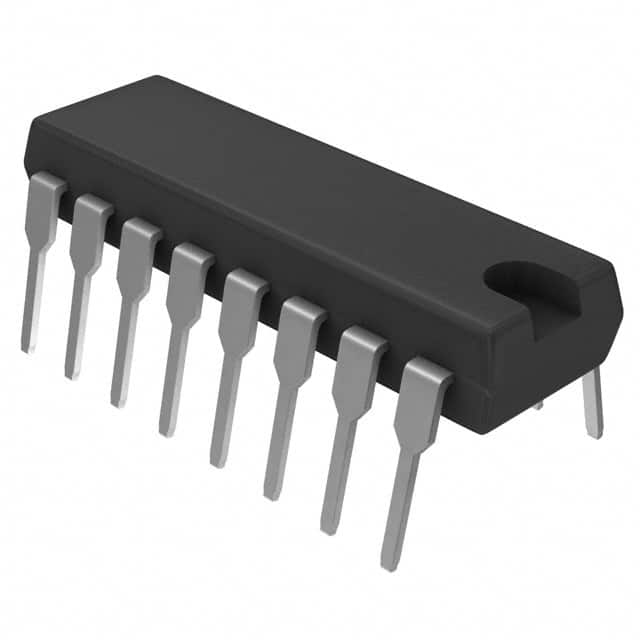Viz Specifikace pro podrobnosti o produktu.

CD74HCT258E
Product Overview
- Category: Integrated Circuit (IC)
- Use: Multiplexer/Demultiplexer
- Characteristics: High-Speed CMOS Logic, 3-State Outputs
- Package: DIP (Dual In-Line Package)
- Essence: The CD74HCT258E is a quad 2-input multiplexer with 3-state outputs. It is designed to select one of four data sources and route it to the output, based on the control inputs.
- Packaging/Quantity: The CD74HCT258E is typically sold in reels or tubes, containing multiple units.
Specifications
- Supply Voltage: 2V - 6V
- Input Voltage: 0V - VCC
- Output Voltage: 0V - VCC
- Operating Temperature: -40°C to +85°C
- Propagation Delay: 9 ns (typical)
- Output Current: ±4 mA
Pin Configuration
The CD74HCT258E has a total of 16 pins, which are assigned specific functions as follows:
- A1: Input A1
- B1: Input B1
- Y1: Output Y1
- GND: Ground
- A2: Input A2
- B2: Input B2
- Y2: Output Y2
- E: Enable Input
- Y3: Output Y3
- B3: Input B3
- A3: Input A3
- Y4: Output Y4
- VCC: Supply Voltage
- B4: Input B4
- A4: Input A4
- GND: Ground
Functional Features
- Quad 2-input multiplexer with 3-state outputs
- Selects one of four data sources based on control inputs
- High-speed CMOS logic for efficient operation
- 3-state outputs allow multiple devices to share the same bus
Advantages and Disadvantages
Advantages
- Versatile multiplexer/demultiplexer functionality
- High-speed operation for efficient data routing
- 3-state outputs enable bus sharing among multiple devices
- Wide operating voltage range (2V - 6V)
- Compact DIP package for easy integration into circuits
Disadvantages
- Limited number of input/output channels (4:1)
- Propagation delay may affect real-time applications
- Requires careful handling due to sensitive CMOS technology
Working Principles
The CD74HCT258E operates as a multiplexer by selecting one of the four input sources (A1, A2, A3, A4) based on the control inputs (B1, B2, B3, B4). The selected input is then routed to the corresponding output (Y1, Y2, Y3, Y4). The E (Enable) input controls the output state, allowing it to be either active or in a high-impedance state.
Detailed Application Field Plans
The CD74HCT258E finds applications in various fields, including:
- Data communication systems
- Digital signal processing
- Industrial automation
- Robotics
- Automotive electronics
- Consumer electronics
Alternative Models
Here are some alternative models that offer similar functionality:
- SN74HCT257E
- CD74HC4051E
- MC14051BCP
- 74HC151N
These alternatives can be considered based on specific requirements and availability.
In conclusion, the CD74HCT258E is a versatile quad 2-input multiplexer with 3-state outputs. It offers high-speed operation, wide voltage range, and compact packaging. While it has limitations in terms of input/output channels and propagation delay, it finds applications in various fields such as data communication, digital signal processing, and industrial automation. Alternative models are available for consideration based on specific needs.
Seznam 10 běžných otázek a odpovědí souvisejících s aplikací CD74HCT258E v technických řešeních
Sure! Here are 10 common questions and answers related to the application of CD74HCT258E in technical solutions:
Q: What is CD74HCT258E? A: CD74HCT258E is a quad 2-input multiplexer with 3-state outputs, commonly used in digital logic circuits.
Q: What is the operating voltage range for CD74HCT258E? A: The operating voltage range for CD74HCT258E is typically between 4.5V and 5.5V.
Q: What is the maximum output current that CD74HCT258E can handle? A: CD74HCT258E can handle a maximum output current of 6mA.
Q: Can CD74HCT258E be used as a demultiplexer? A: No, CD74HCT258E is specifically designed as a multiplexer and does not function as a demultiplexer.
Q: How many inputs does CD74HCT258E have? A: CD74HCT258E has four inputs, labeled A0, A1, A2, and A3.
Q: What is the purpose of the 3-state outputs in CD74HCT258E? A: The 3-state outputs allow multiple CD74HCT258E chips to be connected together without causing conflicts on the shared bus.
Q: What is the typical propagation delay of CD74HCT258E? A: The typical propagation delay of CD74HCT258E is around 15 nanoseconds.
Q: Can CD74HCT258E be used in high-speed applications? A: Yes, CD74HCT258E is suitable for use in high-speed applications due to its fast switching characteristics.
Q: What is the maximum power dissipation of CD74HCT258E? A: The maximum power dissipation of CD74HCT258E is 500mW.
Q: Can CD74HCT258E be used in both commercial and industrial applications? A: Yes, CD74HCT258E is designed to meet the requirements of both commercial and industrial applications.
Please note that these answers are general and may vary depending on specific datasheet specifications or application requirements.

